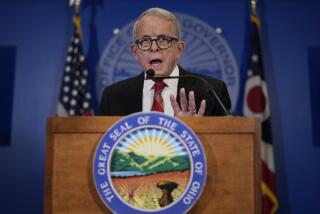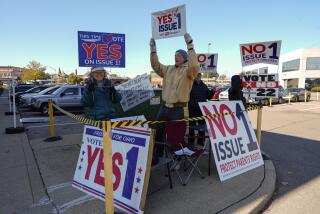Surveying Ohio’s Democratic terrain
- Share via
COLUMBUS, OHIO — A campaign for the Democratic presidential nomination that has pivoted on race and gender could be decided here today by another divide, the state’s urban north versus the rural south -- pitting Ohio’s popular governor against a cadre of big-city mayors.
While Sens. Hillary Rodham Clinton of New York and Barack Obama of Illinois have built their own campaign organizations in Ohio, they also have tried to tap into political machines directed by successful Democratic political leaders, local analysts say.
Clinton has the backing of freshman Gov. Ted Strickland, who long represented the southeastern Appalachian region in Congress. Obama has the backing of the mayors of the state’s three largest cities, Columbus, Cleveland and Cincinnati.
The mayors’ ties to local political bases could be significant in a state where recent polls showed Clinton with a 6-point lead and 1 in 10 voters still undecided or uncertain.
“I would rather have the mayors in the major cities [than Strickland’s backing], because that is where more of the vote will come from,” said Herbert B. Asher, a political analyst at Ohio State University who has watched Ohio politics for more than a quarter of a century.
Much like California, Ohio’s political texture changes by geography.
The state’s social and political personality has its own Mason-Dixon line -- Interstate 70, which bisects Columbus, the capital and largest city.
The north is anchored by old industrial centers like Cleveland, Akron, Youngstown and, separated by farm areas along Lake Erie, Toledo. In the south, with the exception of Cincinnati, the state is rural and, to the southeast, Appalachian coal country.
The split among Democrats also follows a racial fault line, with Strickland, who is white, on one side and Michael B. Coleman, the African American mayor of Columbus, on the other.
The split is rooted in state politics.
In early 2005, with the governor’s seat opening the next year, Strickland ended speculation that he would seek the office by announcing he would run for reelection to his congressional district, a ribbon of land from the Pennsylvania line southwest along the Ohio River across from West Virginia and Kentucky.
With Strickland out, Coleman announced his candidacy for governor and quickly became the presumptive nominee. But in May, Strickland changed his mind amid reports of party concerns about Coleman’s chances.
Coleman withdrew that November after his wife pleaded guilty to drunk-driving charges. He cited family concerns and the pressures of campaigning while running Columbus.
Other Democratic rifts opened up, including a battle over the state party chairmanship, won by a Strickland backer. Against that backdrop, the state’s black Democratic leaders were slow to endorse Strickland.
The divide was never completely bridged even though once Strickland had won, he tapped Coleman to run his gubernatorial transition team.
Analysts believe Strickland does not have the on-the-ground political networks that the mayors do. In the eight biggest cities, four mayors have endorsed Obama, three are neutral and one -- Akron’s Donald L. Plusquellic -- has endorsed Clinton.
“Strickland largely incorporated a lot of his political machine into the governor’s office,” said Jerid Kurtz, who runs the political Buckeye State Blog and is backing Obama. “That means he doesn’t have the people in place right now to go to to run the phone banks and get local offices in place.”
Under the Democrats’ arcane rules for awarding delegates, whoever dominates the north -- particularly the northeast -- could win most of the 141 Ohio delegates at stake today. Forty-nine are awarded proportionately based on statewide results.
The other 92 are awarded proportionately among the 18 congressional districts. But the districts in the north -- which have more Democrats -- award more delegates per district than those in the south. In fact, the 10 mostly northern districts (some extend south of I-70) will award 56 of the 92 delegates.
But four of the six districts that will award an odd number of delegates -- giving the winner of each district the chance to pick up an extra delegate -- are in the south, a possible advantage for Clinton, who polls show is doing well there, buttressed by Strickland’s endorsement.
Obama is doing well in the central part of the state around Columbus -- Coleman country -- and in Cleveland, where he is backed by white Mayor Frank G. Jackson in a city whose population is divided almost evenly between white and blacks.
The rest of the northeast is up for grabs. And except for a few forays, that is where most of the candidate visits have been.
“Why are they spending all this time up north?” said Gerald J. Austin, a longtime Democratic strategist who is not aligned in the race.
“When you go duck-hunting, you go where the ducks are.”
More to Read
Sign up for Essential California
The most important California stories and recommendations in your inbox every morning.
You may occasionally receive promotional content from the Los Angeles Times.











